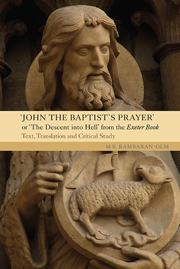 John the Baptist's Prayer 'The Descent into Hell' from the Exeter Book
John the Baptist's Prayer 'The Descent into Hell' from the Exeter Book Published online by Cambridge University Press: 05 August 2014
1 ff. Although the doctrine of the descensus arguably lacks any explicit scriptural references, the apocryphal Gospel of Nicodemus and the Apostle's and (pseudo-) Athanasian Creeds provide the keys to its development, and no doubt the poet would have been acquainted with some form of the narrative to include it as the backdrop for the overriding theme of baptism. See Appendix I for patristic Commentary on the descensus. (Source)
1–16 Conner (1980), pp. 181–3, identifies the liturgical Vespere autem antiphon for Holy Saturday, which is repeated before and after the Magnificat, as a likely immediate source. The prologue's repetition of the women's journey recalls a liturgical echo found in the Mass and divine office. (Source)
18–23 The lines are reminiscent of the Quem quaeritis trope in the Regularis Concordia in which the sorrowful women arrive to an open tomb and are shown the shroud. (Source)
20b Muir (2000), p. 682, states that folde beofode is an exact translation of the Offertory Antiphon for Easter Sunday. (Source)
37–9 Crotty (1939), pp. 355–6, contends that the lines allude to an obscure fourth-century Syrian homily denoting a legendary tale involving John's receipt of armour. (Source)
42b Wræccan þrungon] The image of a throng of people (here the righteous Patriarchs and Prophets in Hell) scrambling over one another to see if they can get a glimpse of the approaching Saviour has a close structural parallel in Christ I, lines 397–9, where a throng of angels similarly scrambles to see which one can get closest to Christ. (Analogue)
59a The liturgical Deo gratias line is represented here. (Source)
To save this book to your Kindle, first ensure no-reply@cambridge.org is added to your Approved Personal Document E-mail List under your Personal Document Settings on the Manage Your Content and Devices page of your Amazon account. Then enter the ‘name’ part of your Kindle email address below. Find out more about saving to your Kindle.
Note you can select to save to either the @free.kindle.com or @kindle.com variations. ‘@free.kindle.com’ emails are free but can only be saved to your device when it is connected to wi-fi. ‘@kindle.com’ emails can be delivered even when you are not connected to wi-fi, but note that service fees apply.
Find out more about the Kindle Personal Document Service.
To save content items to your account, please confirm that you agree to abide by our usage policies. If this is the first time you use this feature, you will be asked to authorise Cambridge Core to connect with your account. Find out more about saving content to Dropbox.
To save content items to your account, please confirm that you agree to abide by our usage policies. If this is the first time you use this feature, you will be asked to authorise Cambridge Core to connect with your account. Find out more about saving content to Google Drive.